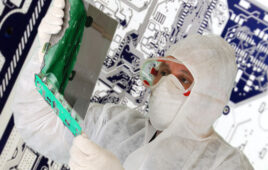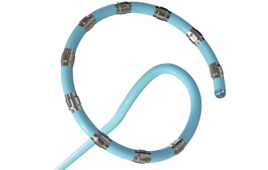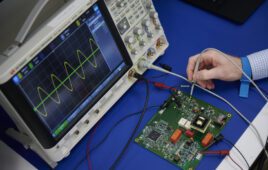
The Pure EP technology records and displays high fidelity cardiac signals with intuitive visualizations tools, which may allow electrophysiologists to better characterize tissue during ablation procedures.
Startups, as a rule, should have a plan for their technology to grow. But it is rare that a medical technology startup aims to be plug and play, fitting into many therapeutic areas from cardio to Alzheimer’s to diabetes.
BioSig’s Pure EP, an electrophysiology signal recording and processing system, could potentially provide valuable insight during surgical procedures – cutting time spent in the OR and increasing the confidence of surgeons that they are making the right decisions in real time.
BioSig (Los Angeles) has a lot of steps to take, however, before it realizes the full potential of Pure EP.
Nonetheless, the company’s co-founder, board chair and CEO Ken Londoner believes the technology is unique among medtech products.
“We’re looking at this as almost like a new branch of medicine,” he said. Londoner believes that many complicated diseases – such as Alzheimer’s, hypertension, obesity or diabetes – can be improved by using electrical devices and electrical catheters.
“One important way to improve surgical treatment is if surgeons can see the body’s biomedical signals in an accurate way,” Londoner said.
For now, the company is focusing Pure EP to improve how surgeons detect cells that cause deadly arrhythmias. It will soon submit a 510(k) and is planning for clearance in 2018.
Getting to a plug and play platform
Londoner and his team have spent the last nine years moving BioSig from research, through proof of concept and prototyping, to a finished product that Londoner said is on track to be FDA cleared in 2018.
But simply getting a product to market isn’t what BioSig is all about. Londoner said it was important to find the right technology that offers an important advantage to the healthcare industry.
“In electrophysiology technology, there’s been a history of devices coming into the market that seem interesting, look novel from a technical standpoint, but don’t improve clinical outcomes or don’t really improve the economic proposition for the hospital or the procedure. It just adds costs. We know in healthcare that’s the wrong way to go in terms of a trend.”
To ensure that Pure EP isn’t a time drain, the BioSig team early in development spent time observing procedures at leading centers. They sought to build a biomedical signaling process system that would improve the way procedures are done, in terms of workflow and accuracy. Efforts to engage directly with experts have continued through the initial box build, prototyping and preclinical studies.
“All along the way, [key opinion leaders] have provided guidance and information insight on how to make the system better, more useful, to create applications that would solve some of the technical challenges,” Londoner said. “I like to tell people that this device was actually built by the leaders of the industry for the benefit of the industry.”
The device developed by BioSig aims to treat complex arrhythmias by reducing artifact noises that can come from diagnostic catheters, machines in the operating room and other biosignals within the body. In existing systems, arrhythmia signals can get lost among the noises, and surgeons cannot detect whether there are phantom signals, small amplitude waveform changes or the intercardiac signals the surgeon needs. The confusion about noise can often cause a delay in the operation, adding to surgical time.
BioSig’s technology removes those artifact noises and provide clear information about the heart function to help surgeons improve their ablation strategy and targeting during a procedure.
Londoner sees a future of partnerships among industry leaders in the cardio space. The position of Pure EP as a value-add to existing technologies is no accident: It’s the nature of the technology. Londoner isn’t interested in competing head-to-head with some of the largest medical device companies in the world that supply ablation technologies. “We think our clean signals make a lot of the existing technologies perform better. We can help mapping companies solve some of their noise problems and help catheter companies get better ablation outcomes.”
At heart, BioSig’s vision is to provide better tools to lead to better outcomes.
A long-term strategy
It’s not often that startups open with the pitch that they’re taking the long road, but that is what Londoner says about BioSig Technologies and its imminent entry into the medtech space.
“There aren’t a lot of companies that will take on the duty of building and growing an organization long-term. They want to exit. They want to flip the asset and sell it to somebody and go sit on a yacht somewhere. We’re into driving the science deep into the market, partnering with leaders to find a way to make better use of these biomedical signals.”
Such conviction in the future of BioSig has driven every decision Londoner and his team have made. Londoner is not interested in an early exit. This is why BioSig has never taken venture capital money.
Londoner explained that if the company had gone that route, “We’d never make it. The demands of getting a return on investment or insisting we put a product out on the market that might not have been as good as it could be … would compromise the work we are trying to do.”
Instead, Londoner has relied on investments from industry experts, many of whom now serve on the board. “We are a public company, and we do care about creating value.”
Londoner is aware that there is still more to be done. “Just because we have a couple [key opinion leaders] and a couple centers publishing very nice-looking preclinical data, doesn’t mean we’re reached anywhere near where we want to get to.”
But he is also confident that he has a recipe for success. “We’ve got quality technology, KOLs, corporate executives and investors: We’d like to be in this business a long time.”




